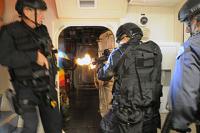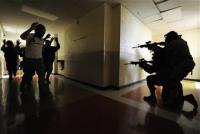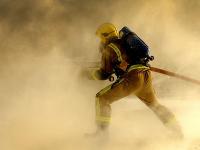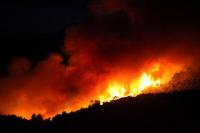-
FDA clears military traumatic wound dressing for use in civilian population
Early control of severe bleeding may prevent shock and may be life-saving., as 30 to 40 percent of civilian deaths by traumatic injury are the result of hemorrhaging. Of those deaths, 33 to 56 percent occur before the patient reaches a hospital. Last week the FDA cleared the use of the XSTAT 30 wound dressing, an expandable, multi-sponge dressing used to control severe, life-threatening bleeding from wounds in areas that a tourniquet cannot be placed (such as the groin or armpit) in battlefield and civilian trauma settings.
-
-
Human skin detection technology improves security, search and rescue
Color-image based systems are excellent at locating people in aerial search and rescue operations, but fall short when it comes to discerning between actual human skin and objects with similar hues. To remedy this, researchers have developed a novel two-dimensional feature space which uses the spectral absorption characteristics of melanin, hemoglobin and water to better characterize human skin.
-
-
Improving police responses to mass shootings

Before Columbine, law enforcement acted on the assumption that mass casualty incidents would involve a barricaded lone shooter who could be isolated, or a hostage situation in which the attackers would engage in negotiation before they killed more people. Thus, protocols established after the 1966 sniper attack at the University of Texas, called for first responders in the United States to set up a perimeter around the site of the shooting, gather as much information as possible, and then wait for specially trained assault teams, hostage negotiators, medics, and other specialists to arrive. “The assumption,” one expert said, “was that time was on their side.” Police forces arriving on the scene of a shooting no longer entertain this assumption.
-
-
DHS, NYPD train on response to active shooters

After months of coordination between the Department of Homeland Security (DHS) Science and Technology Directorate (S&T) and the New York Police Department (NYPD) Counter Terrorism Division, the NYPD conducted an active shooter training exercise on 22 November. S&T says that the exercise not only tested their training and proficiency, but also allowed them to incorporate several commercial technologies that could benefit future emergency situations.
-
-
New sensors detect cable fire before it starts burning
Fires are frequently caused by smoldering cables. New sensors now help detect such smoldering fires at an early stage by analyzing the plastic vapors released by overheated insulating cables. Scientists have developed these hybrid sensors that combine measurement processes with data evaluation. These detect the gases released from the plastic coating due to heating and reliably identify and analyze the gas mixture and its concentration.
-
-
Demonstrating technologies for disaster response
Radiological incidents such as Chernobyl and Fukushima illustrate the need for effective coordination of federal, state, and local agencies in response efforts. Earlier this year, the Department of Homeland Security (DHS) Science and Technology Directorate’s (S&T) National Urban Security Technology Laboratory (NUSTL) and the Environmental Protection Agency (EPA) demonstrated new technology developments at the Columbus, Ohio, Battelle Memorial Institute facility that will enable more effective radiological decontamination.
-
-
Online residential fire simulation tool for training firefighters
Firefighting is not what it used to be. Whether it is a complex blaze raging in an urban high-rise or a seemingly straightforward single-level home fire, modern building construction and furnishings have made fighting fires more difficult: Flames burn hotter, produce more smoke, and spread more quickly. But fire research has advanced, too, and researchers are working with five major urban fire departments to build new knowledge on modern residential firefighting into game-based online simulations with an engaging, dynamic format.
-
-
Technology confronts disasters
In 2010, soon after Haiti was devastated by an earthquake, a team from MIT Lincoln Laboratory collected and analyzed information to help the U.S. Southern Command (USSOUTHCOM), the lead military agency responding to the crisis, effectively dispatch vital resources, including food, water, tents, and medical supplies, to the victims of this disaster. This Haiti experience demonstrated to Lincoln Laboratory researchers that advanced technology and technical expertise developed for the Department of Defense (DoD) can significantly benefit future humanitarian assistance and disaster relief efforts. In February, the Laboratory established the Humanitarian Assistance and Disaster Relief (HADR) Systems Group to explore ways to leverage or advance existing capabilities for improving disaster responses.
-
-
DHS recruits Silicon Valley entrepreneurs to develop first-response technology
DHS wants better technology for first responders — police, firefighters, and EMTs — but rather than pushing for innovation from within the massive corporations that already provide technology to government agencies, the DHS has come to Silicon Valley to tap the entrepreneurial ecosystem of northern California. Giant technology firms have resources of large scale manufacturing and distribution, but there is one crucial difference. Technology startups are much more nimble, and can shift their development much faster than the huge corporations can.
-
-
Teams of computers and humans more effective in disaster response
Crisis responders need to know the extent of a natural disaster, what aid is required and where they need to get to as quickly as possible — this is what’s known as “situation awareness.” With the proliferation of mass media, a lot of data is now generated from the disaster zone via photographs, tweets, news reports and the like. With the addition of first responder reports and satellite images of the disaster area, there is a vast amount of relevant unstructured data available for situation awareness. A crisis response team will be overwhelmed by his data deluge — perhaps made even worse by reports written in languages they don’t understand. But the data is also hard to interpret by computers alone, as it’s difficult to find meaningful patterns in such a large amount of unstructured data, let alone understand the complex human problems that described within it. Experts say that joint humans-computers teams would be the best way to deal with voluminous, but unstructured, data.
-
-
Seeing through the dark clearly

A new device, dubbed Thermal on Demand (TOD), allows firefighters to see everything in a heavily smoke-filled room, where the unassisted eye sees nothing but a pitch-black environment. TOD allows responders to see doors, furniture, light switches, debris on the floor, and victims lying on the floor. Looking through a periscopic lens, in front of a thermal camera, the wearer sees a detailed image of everything in the immediate vicinity.
-
-
Wearable device helps medics save lives in disasters, on the battlefield
The First Response Monitor is a wearable device designed to measure and monitor the vital signs of multiple trauma patients for emergency response in disasters and battlefield situations. The device has been primarily designed with first response medics in mass casualty incidents in mind, but it has applications in many other fields — such as civilian medicine where additional monitoring of conditions has benefit in patient outcomes, wellness monitoring, and within sports for training and performance monitoring.
-
-
Hundreds of fires blazing across more than 1.1 million acres in the West

Wildfires have been ravaging large parcels of land in the West and there seems to be no end in sight for the weary Westerners. There are hundreds of individual fires blazing across at least 1.1 million acres in the West. Both the military and foreign firefighting crews have been called in to help the beleaguered firefighters in the West. Washington State’s firefighters are stretched to the limit, and on Friday the state’s Department of Natural Resources (DNR) opened centers in Omak and Colville to coordinate offers of help from trained, qualified volunteer firefighters and from people who have and can operate machinery like backhoes and bulldozers to dig fire lines.
-
-
DHS S&T licenses innovative communication technology to commercial partners
DHS Science and Technology Directorate (S&T) last week announced that it has licensed the Radio Internet-Protocol Communications Module (RIC-M) to two commercial partners. RIC-M, used by local, state, and federal responders, is a low-cost, external, stand-alone, interface device that connects radio frequency (RF) system base stations, consoles and other RF equipment — regardless of brand — over the Internet or Private Internet Protocol (IP) network.
-
-
Historic drought complicates firefighting in California
The twenty-one wild fires which have erupted in different parts of the state have already cost lives, dozens of homes, and millions of dollars in damages. To fight fires, firefighters need water – and although state water and fire officials say that, so far, there is no danger of running out of water, they are conscious of the state’s water predicament and they are trying to be more careful in the use of water. The persistent drought has forced crews to get creative, using more dirt and retardant on wildfires. Firefighting response to several blazes has been slowed down by the drought, because firefighting helicopters found it impossible to siphon water from lakes and ponds where water levels were lower than in previous years. In the past, property owners whose properties were threatened by fire, would allow firefighting crews to tap water on their property, and would then be compensated by cash reimbursements from the state. Now, many property owners demand instead that the state replenish the water used by firefighters to protect the owners’ property.
-
- All
- Regional
- Water
- Biometrics
- Borders/Immig
- Business
- Cybersecurity
- Detection
- Disasters
- Government
- Infrastructure
- International
- Public health
- Public Safety
- Communication interoperabillity
- Emergency services
- Emergency medical services
- Fire
- First response
- IEDs
- Law Enforcement
- Law Enforcement Technology
- Military technology
- Nonlethal weapons
- Nuclear weapons
- Personal protection equipment
- Police
- Notification /alert systems
- Situational awareness
- Weapons systems
- Sci-Tech
- Sector Reports
- Surveillance
- Transportation
Advertising & Marketing: advertise@newswirepubs.com
Editorial: editor@newswirepubs.com
General: info@newswirepubs.com
2010-2011 © News Wire Publications, LLC News Wire Publications, LLC
220 Old Country Road | Suite 200 | Mineola | New York | 11501
Permissions and Policies
Editorial: editor@newswirepubs.com
General: info@newswirepubs.com
2010-2011 © News Wire Publications, LLC News Wire Publications, LLC
220 Old Country Road | Suite 200 | Mineola | New York | 11501
Permissions and Policies
